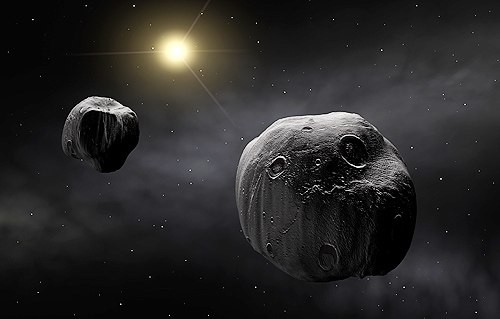Berkeleyan
 |
Now we know the rubble they've seen
Amateur and professional astronomers combine their observations to resolve image of twin asteroids
![]()
| 04 April 2007
Roping together observations from the world's largest telescopes as well as the small instrument of a local backyard amateur, astronomers have assembled the most complete picture yet of a pair of asteroids whirling around one another in a perpetual pas de deux.
In a paper to be published in the April issue of the journal Icarus, a team of Berkeley and Paris Observatory astronomers depict the asteroid 90 Antiope as two slightly egg-shaped rubble piles locked in orbit, like two twirling dancers facing one another.
This new view of Antiope is the culmination of research that started in 2003 and that eventually included data supplied by professional and amateur astronomers from around the globe.
Before the year 2000, Antiope was just another main-belt asteroid, one of millions between the orbits of Mars and Jupiter. But that year it was resolved into a doublet, thanks to sharper pictures obtained with adaptive optics (AO) on the largest ground-based telescope, the 10-meter Keck II telescope in Hawaii. Yet, even with AO, these two asteroids were too small for astronomers to discern their shape or to see more than two bright blobs revolving around their center of mass.
Two years ago, with improved images from the European Southern Observatory's 8-meter Very Large Telescope (VLT) in Chile and Keck II, Berkeley astronomer Franck Marchis and colleagues in France were able to determine the orbits of the two asteroids, each of them about 86 kilometers in diameter and separated by about 171 kilometers.
But uncertainties remained, and in 2005 the team invited observers around the world to turn their telescopes on the asteroid pair during a time when they predicted a mutual eclipse or occultation would cause a drop in brightness. In an eclipse, one of the pair casts a shadow over the other; in an occultation, one passes in front of, and completely blocks light from, the other.
Sure enough, at the appointed time on May 31, 2005, one of the asteroids eclipsed the other, and team member Tadeusz Michalowski e-mailed Marchis and their colleagues from South Africa to confirm the eclipse. Michalowski, an astronomer at Adam Michiewicz University's Astronomical Observatory in Poznan, Poland, recorded the dip in Antiope's brightness from the South African Astronomical Observatory.
Over the next six months, at Marchis' invitation, amateurs and professionals from as far afield as Brazil, France, and Reunion Island in the Indian Ocean - and as close to Berkeley as the Gold Country town of Grass Valley - observed repeated occultations, as well as shadows passing over one of the pair.
"This is the first publication I've had in a professional journal, and I'm really happy about it," says amateur astronomer Peter Dunckel, 75, a retired paper-company executive who observes from the backyard of his vacation home in Grass Valley. "What is really a thrill is to have my little 7-inch telescope along with an 8-meter telescope on the same paper; it is unbelievable."
Dunckel observed the binary pair for 35 hours over a period of six weeks, recording Antiope's brightness every minute with a CCD camera attached to his Maksutov Newtonian reflector telescope.
"Amateurs can be used for professional studies, compensating for the small size of their telescopes by the large numbers of observations and the frequency of observations they can do," Marchis says. "You can time the orbits more precisely when a mutual event happens, which allows you to extract also the size, shape, and surface detail of each component, and also what it's made of."
Marchis and his team are employing both amateur and professional astronomers to observe more of these mutual events between components of binary asteroid systems. These partnerships are a powerful way to get direct and accurate insights about these systems, he says.
As for Dunckel, who commutes from San Francisco to the Grass Valley vacation home he refers to as "Rattlesnake Creek Observatory," he says he's hooked on scientific amateur observing, "now that I've broken the dam, so to speak." He has upgraded to a 10-inch reflecting telescope and is excited about applying a new computer program that will allow him to create 3D models of asteroids from light curves he obtains in collaboration with others.

